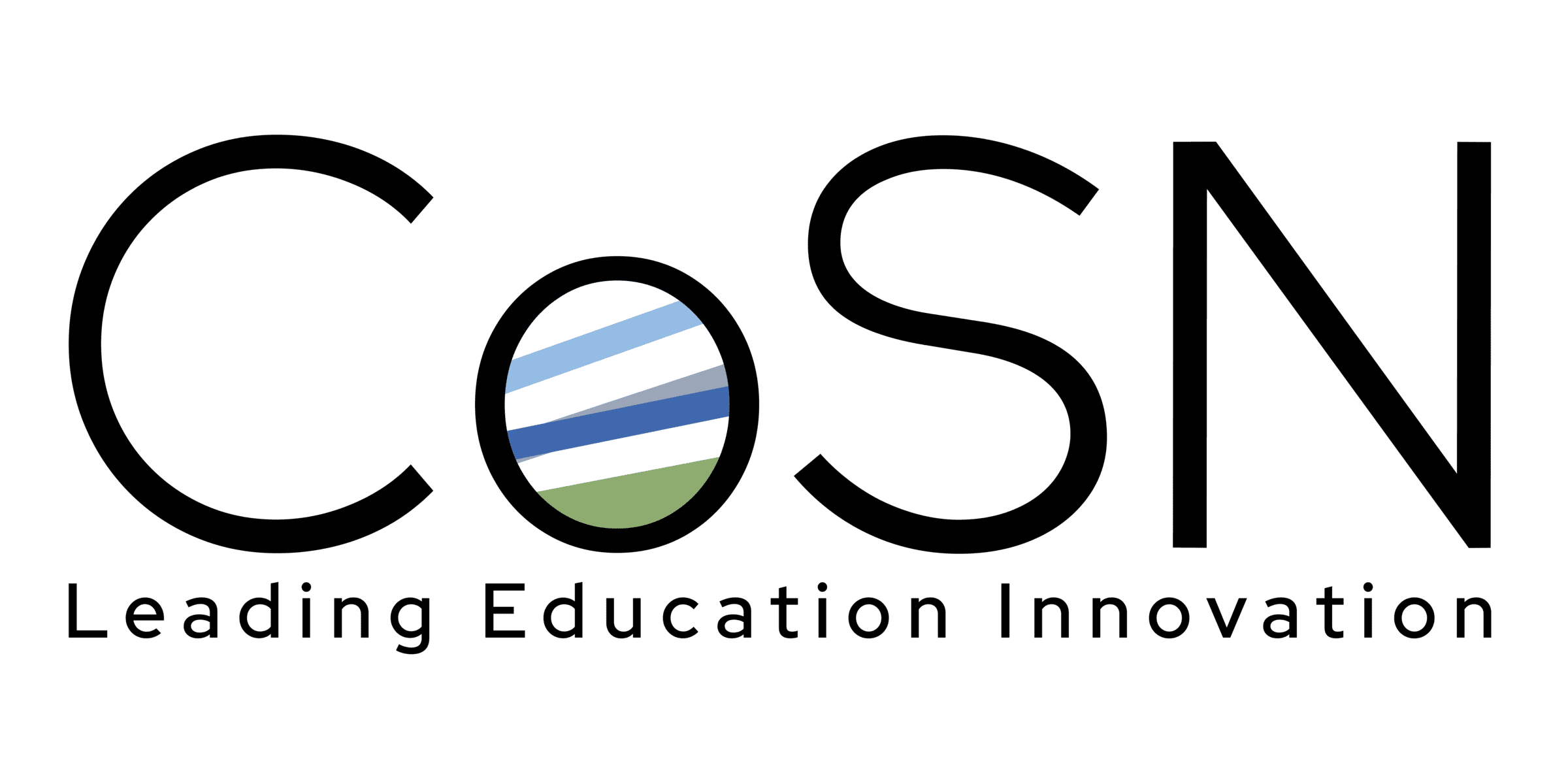Washington, D.C. (September 15, 2025) – The Consortium for School Networking (CoSN) and SETDA issued the following statement on the future of the Universal Service Fund (USF). Together, CoSN and SETDA bring state and school district perspectives on why the USF — particularly the E-Rate program — is essential to ensuring every school and library has affordable, high-capacity broadband and other advanced communications services, as envisioned by the Telecommunications Act of 1996.
The Importance of Broadband for Learning
Secure, high-capacity broadband is as fundamental to today’s schools as textbooks and electricity. Without it, students cannot access the modern learning experiences that define education in the 21st century. As the 2024 National Educational Technology Plan emphasizes, technology enables students to extend learning beyond the classroom, collaborate with peers and experts worldwide, and engage in creative, self-directed, and immersive learning experiences. Without robust and universal broadband access, schools cannot provide the active, technology-enabled learning environments that students deserve, including the responsible and universal use of Artificial Intelligence.
Our organizations remain steadfast in support of the Universal Service principles of the 1996 Telecommunications Act, which seek to ensure that all Americans — including those in rural, high-cost and low-income areas, as well as schools, libraries and health care providers — have access to affordable, high-quality, advanced telecommunications services, supported by fair contributions and predictable funding mechanisms.
The Success of E-Rate in Connecting Schools and Libraries
Nearly 30 years after its creation, the bipartisan E-Rate program stands as one of the most effective and enduring federal broadband initiatives. Thanks to E-Rate, nearly all schools and libraries — public and private, urban and rural — are connected to broadband for digital learning.
Key findings from recent surveys underscore its impact:
- Universal Reach: 99% of public school students and 45% of private school students benefit from internet access made possible by E-Rate (2024 E-Rate Funding Applications).
- Vital Support: Over 90% of applicants report that E-Rate is essential to meeting their internet connectivity goals (2024 E-Rate Trends Report).
- Expanded Connectivity: 89% of applicants say they can connect more students and library patrons because of E-Rate (2024 E-Rate Trends Report).
- Critical Reliance: Without E-Rate, 74% of districts would face a major or catastrophic impact on operations — with rural (74%) and city (78%) districts most vulnerable (CoSN 2025 State of EdTech District Leadership report).
The Supreme Court’s recent affirmation of USF’s constitutionality provides stability, but long-term sustainability requires congressional action to ensure fairness in the contribution base and predictability in funding.
Emerging Challenges: Home Access and Cybersecurity
When Congress enacted the Telecommunications Act of 1996, it recognized that “universal service is an evolving level of telecommunications services” (Telcom Act, Sec.254(c)). While E-Rate has been enormously successful, today’s connectivity needs have expanded. Two areas demand particular attention:
Home Connectivity Gaps
- Only 7% of school districts report that all students have adequate home internet for learning (CoSN 2025 State of EdTech District Leadership report).
- 64% of E-Rate applicants cite inadequate home internet as a significant issue in their communities (2024 E-Rate Trends Report).
- State education agency investment in broadband has declined by 11 percentage points from 2024 to 2025 (SETDA 2025 Stated EdTech Trends Report).
- Nearly 70% of applicants would seek hotspot funding if eligible under E-Rate (2024 E-Rate Trends Report).
Cybersecurity Threats
- Since 2017, more than 95% of applicants have urged that network security and management tools be eligible for E-Rate (2024 E-Rate Trends Report).
- The FCC’s $200 million Cybersecurity Pilot is a major step forward, but its limited scope cannot meet the magnitude of need.
- Districts are already straining budgets: 61% rely on general funds for cybersecurity, while 78% spend on monitoring/detection tools rather than comprehensive protections (CoSN 2025 State of EdTech District Leadership report).
- State investment in cybersecurity risk mitigation for schools has declined significantly — more than doubling the percentage of leaders reporting very little state support between 2024 and 2025 (SETDA 2025 State EdTech Trends Report).
Recommendations for the USF Working Group
To preserve E-Rate’s legacy while adapting to today’s challenges, SETDA and CoSN respectfully recommend Congress and the USF Working Group to:
- Reaffirm Congressional Commitment to E-Rate: Recognize E-Rate’s unparalleled role in fulfilling the universal service mandate for schools and libraries.
- Modernize to Address Cybersecurity: Expand E-Rate’s eligible services to cover a range of cybersecurity protections such as next-generation firewalls, endpoint security and filtering — services that districts consistently identify as priorities (2024 E-Rate Trends Report). The working group should evaluate outcomes of the E-Rate Cybersecurity Pilot program to determine how federal agencies can continue supporting this issue after the pilot’s conclusion, especially in light of recent unilateral administration cuts to CISA’s support for schools, including MS-ISAC.
- Support Sustainable Home Connectivity: Coordinate E-Rate with the High-Cost program and BEAD to address persistent home access gaps and meet community broadband needs. We encourage the working group to make clear that “classrooms” are any location where a student is learning, including designating mobile hot spots, bus Wi-Fi and other off-campus connection strategies as eligible E-Rate services, and to work with the Department of Commerce, the FCC and other agencies to speed deployment of other broadband connectivity funds.
- Ensure Long-Term USF Sustainability: Broaden the existing USF structure’s contribution base to stabilize funding and maintain the program’s independence from the annual appropriations process, while continuing its strong accountability and transparency (CoSN/SETDA Principles Statement).
These recommendations are grounded in SETDA’s Universal Connectivity Imperative, which sets five goals to ensure every student has the access, devices, skills and protections they need to thrive in today’s modern society. They are reinforced by CoSN’s commitment to equipping district technology leaders with the professional development, knowledge and community needed to put these goals into practice at the local level. By modernizing E-Rate and strengthening the Universal Service Fund, Congress can deliver on this shared imperative: sustaining the progress schools have made, closing persistent gaps in home connectivity, protecting students and educators from cyber threats, and ensuring that universal access remains both fair and sustainable for the future.
E-Rate has transformed U.S. education by connecting nearly every school and library to the internet. But progress is fragile. Cybersecurity threats are accelerating, state broadband funding is declining and millions of students remain without adequate home access.
We urge the Senate USF Working Group to reaffirm bipartisan support for E-Rate and modernize it to meet today’s realities. By sustaining and strengthening E-Rate and the broader USF programs, Congress can ensure that every student, regardless of geography or income, has access to the digital tools and opportunities they need to succeed.
To learn more about CoSN’s advocacy efforts, visit: https://www.cosn.org/advocacy-policy/
About CoSN
CoSN, the world-class professional association for K-12 EdTech leaders, stands at the forefront of education innovation. We are driven by a mission to equip current and aspiring K-12 education technology leaders, their teams, and school districts with the community, knowledge, and professional development they need to cultivate engaging learning environments. Our vision is rooted in a future where every learner reaches their unique potential, guided by our community. CoSN represents over 13 million students and continues to grow as a powerful and influential voice in K-12 education. www.cosn.org/
About SETDA
SETDA is the principal membership organization serving edtech and digital learning leaders from every U.S. state and territorial education agency. Since 2001, SETDA has supported state education agencies in leveraging technology to strengthen teaching, learning, and school operations—contributing to sustained impact across the education landscape. Through cross-sector partnerships, professional development, and advocacy at the federal level, SETDA works to ensure every student has access to high-quality digital learning opportunities. www.setda.org/
MEDIA CONTACT:
Grace Helsing, ghelsing@fratelli.com
SETDA: media@setda.org

